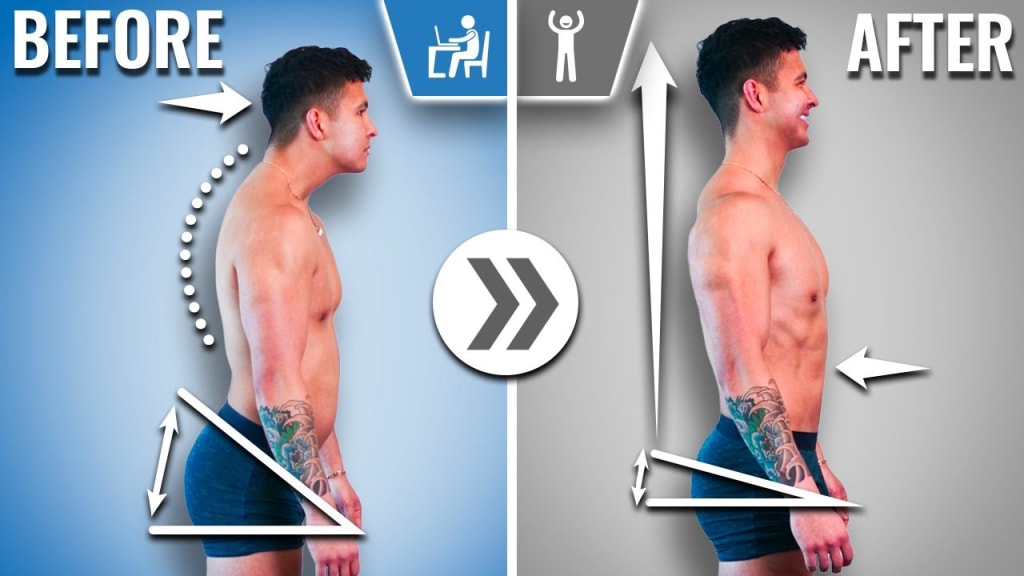Five-Minute Posture Routine: Correcting Forward Head, Rounded Shoulders, and Donald Duck Butt
The Five-Minute Posture Routine

Five-Minute Posture Routine: Correcting Forward Head, Rounded Shoulders, and Donald Duck Butt
________________________________________
Table of Contents
1. Introduction
2. Understanding Poor Posture
• Sitting Habits and Consequences
• The Significance of Slouching
3. The Five-Minute Posture Routine
• Exercise 1: Opening up the Chest and Shoulders
• Exercise 2: Unlocking the Mid and Upper Back
• Exercise 3: Strengthening the Back and Shoulders
• Exercise 4: Loosening the Hip Flexors
• Exercise 5: Strengthening the Glutes
4. Incorporating Movement and Exercise into Daily Life
• The Importance of Being Active
• Weightlifting and Flexibility
5. Conclusion
6. Frequently Asked Questions (FAQs)
1. How often should I perform the five-minute posture routine?
2. Can the posture routine be done by people of all fitness levels?
3. Will the exercises alone fix my posture?
4. Can the routine help with other posture-related issues?
5. Should I consult a healthcare professional before starting the routine?
________________________________________
Introduction
In today's digital age, poor posture has become a prevalent issue affecting individuals of all ages. The constant use of electronic devices and prolonged sitting in front of screens has led to the development of forward head posture, rounded shoulders, and even the dreaded "Donald Duck Butt" appearance. However, with a simple and effective five-minute posture routine, you can take proactive steps to correct these postural imbalances and improve your overall well-being. In this article, we will delve into the causes of poor posture, explore the benefits of the five-minute routine, and provide detailed instructions on how to perform each exercise correctly.
________________________________________
Understanding Poor Posture
Sitting Habits and Consequences
Research reveals that the average person spends six to eight hours per day sitting, often adopting a slouched position. While slouching isn't necessarily detrimental in the short term and may even aid concentration, spending prolonged periods in this hunched-over posture can have negative consequences. Over time, your body adapts to this posture by tightening certain muscles and weakening others, which reinforces the slouched position.
The Significance of Slouching
Slouching contributes to the development of forward head posture, where the head protrudes forward, causing strain on the neck and upper back. Rounded shoulders are another common consequence of poor posture, where the shoulder blades become excessively rounded forward, leading to imbalances in the shoulder girdle. Additionally, the "Donald Duck Butt" appearance refers to an exaggerated arch in the lower back, caused by weak glute muscles and tight hip flexors.
________________________________________
The Five-Minute Posture Routine
To counteract the effects of poor posture, we present a five-minute routine consisting of five simple yet highly effective exercises. These exercises target various muscle groups to reverse the postural imbalances caused by prolonged sitting. By incorporating this routine into your daily schedule, you can alleviate discomfort, enhance posture, and experience improved overall mobility.
Exercise 1: Opening up the Chest and Shoulders
To start, you can use a band, towel, or broomstick. Place your hands inside the band with your palms facing away from the sides of your thighs. If using a towel or broomstick, grab it with a wide overhand grip. Keep your arms straight and move them in a circular motion up and behind your body. Allow your shoulder blades and traps to shrug up slightly on the way up, then let your shoulder blades come down and back as your arms travel behind your body. The band provides the advantage of adjustability by widening it to accommodate your tightness. Ensure your core is engaged to prevent arching your lower back.
Exercise 2: Unlocking the Mid and Upper Back
Assume an all-fours position with your hands under your shoulders and knees under your hips. For enhanced effectiveness, place a foam roller, ball, or folded pillow between your legs and squeeze it. Engage your core, straighten your back, and push the floor away to extend your arms fully. Take a deep breath out as you reach your left arm under and across your body as far as possible, feeling a stretch in your mid and upper back. Bring your left hand back behind your neck, push the floor away with your right hand, and rotate your left elbow up towards the ceiling, following it with your eyes. Perform this on both sides, aiming to increase your range of motion gradually.
Exercise 3: Strengthening the Back and Shoulders
Lie on your stomach with your forehead on the floor or slightly elevated. Position your hands behind your head with elbows pulled back, imagining squeezing your shoulder blades together. Extend your arms straight out, forming a capital "Y" shape with your palms facing the floor. Keep your arms straight and lifted as high as possible, feeling the engagement in your mid-back and shoulder muscles. Move your arms in a circular motion, transitioning to the "T" shape as your palms face the ceiling. Bend your elbows, placing the back of your hands on your low back. Then reverse the circle back to the starting position. This exercise can be challenging, so modify it by focusing on the "T" shape initially and gradually progressing to the full exercise.
Exercise 4: Loosening the Hip Flexors
Start on all fours and position your right knee close to a wall, bench, or elevated furniture. Place your back foot against the wall or bench, adjusting the distance according to your flexibility. Experience a deep stretch in your quads and hip flexor of the back leg. Maintain a stable core, level your hips, and avoid arching your lower back. Experiment with leaning forward or pushing your butt back to intensify or lessen the stretch, respectively. Perform this stretch consistently to address any imbalances and reduce hip flexor tightness over time.
Exercise 5: Strengthening the Glutes
Lie on your back with knees bent and feet flat on the floor. Angle your elbows away from your body and press them into the ground. Engage your core to flatten your lower back against the floor, then squeeze your glute muscles tightly as you lift your hips. Maintain the contraction at the top, ensuring you don't arch your lower back. Keep your core engaged, tilt your hips back by squeezing the glutes, and prevent any overarching. Hold this position for five seconds before lowering your hips for another repetition. Focus on feeling the activation in your glutes rather than your quads or hamstrings.
________________________________________
Incorporating Movement and Exercise into Daily Life
While the five-minute posture routine is highly effective, it is crucial to supplement it with overall lifestyle changes to optimize your posture and well-being.
The Importance of Being Active
In addition to performing the routine consistently, it is essential to increase your overall movement and avoid prolonged sitting. Incorporate regular breaks throughout the day, engage in more standing activities, and take frequent walks. Consider exploring workout videos or weightlifting programs to enhance flexibility, posture, and overall health. Lifting weights, in particular, has been shown to improve flexibility as effectively as stretching.
Weightlifting and Flexibility
Visit BuildWithScience.com to access evidence-based weightlifting programs tailored to your needs and goals. These programs provide detailed workout
About the Creator
Latif Khan
Our page is Motivated,Arts,Excited and Indifferent.In this page, our Article is about Health,Food,Fashion,Humanity,Exercise,Social activity,Society etc
Thanks for watching and your support our articles in my page






Comments
There are no comments for this story
Be the first to respond and start the conversation.